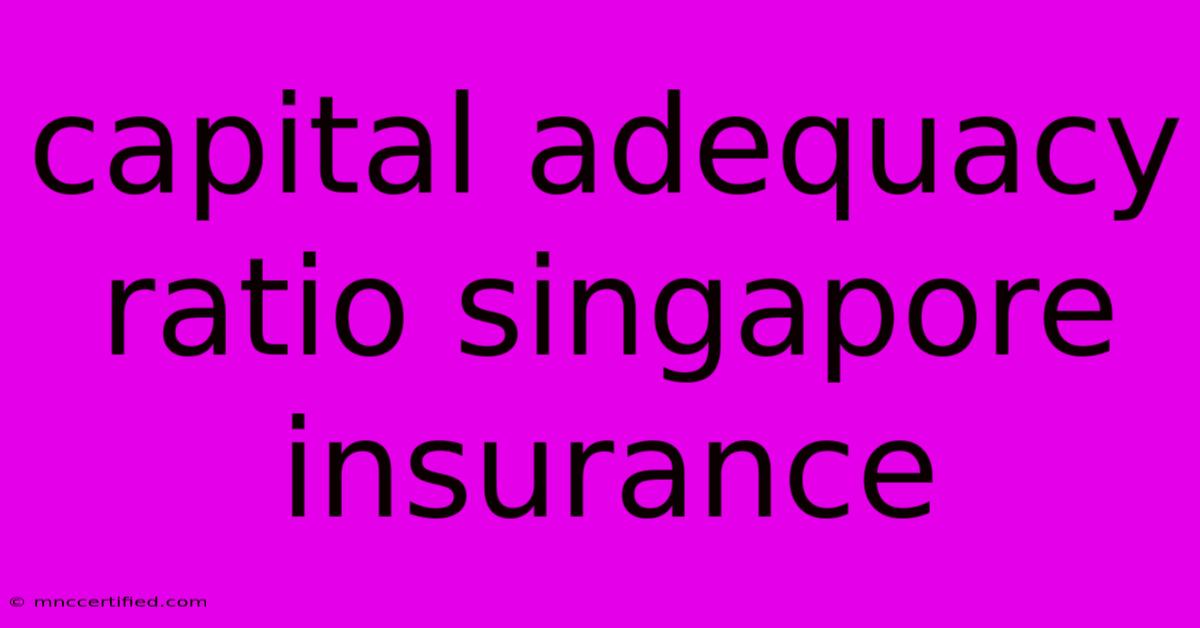Capital Adequacy Ratio Singapore Insurance

Table of Contents
Capital Adequacy Ratio: A Crucial Metric for Singapore's Insurance Industry
Singapore's insurance industry is a vital component of the country's financial landscape, playing a key role in safeguarding individuals and businesses against various risks. To ensure the stability and solvency of insurance companies, the Monetary Authority of Singapore (MAS) has implemented a comprehensive regulatory framework, including the Capital Adequacy Ratio (CAR). This article delves into the intricacies of the CAR, its significance for the Singapore insurance sector, and its role in fostering a robust and resilient financial ecosystem.
What is the Capital Adequacy Ratio (CAR)?
The Capital Adequacy Ratio (CAR) is a crucial metric used to measure an insurance company's financial strength and its ability to meet its obligations to policyholders. It represents the ratio of an insurer's capital to its risk-weighted assets. In simpler terms, it reflects the amount of capital an insurance company holds relative to the risks it undertakes.
A higher CAR indicates a more financially sound insurer, better equipped to absorb potential losses and fulfill its commitments to policyholders.
The Importance of CAR in Singapore's Insurance Industry
The MAS mandates a minimum CAR for all insurance companies operating in Singapore. This requirement aims to:
- Safeguard Policyholders: By ensuring adequate capital reserves, the CAR protects policyholders from potential losses in the event of an insurer's financial distress.
- Promote Financial Stability: A robust CAR fosters a stable insurance sector, reducing systemic risk and fostering confidence in the financial system.
- Encourage Prudent Risk Management: The CAR incentivizes insurers to adopt sound risk management practices and maintain sufficient capital to cover potential liabilities.
- Support Growth and Innovation: A healthy financial position allows insurance companies to invest in new products and services, promoting innovation and growth within the industry.
CAR Calculation and Requirements in Singapore
The CAR calculation involves several key elements:
- Capital: This includes an insurer's equity capital, surplus, and other eligible assets.
- Risk-Weighted Assets: These are the insurer's assets adjusted based on their inherent riskiness. Different asset classes carry varying risk weights.
The MAS sets specific CAR requirements for different types of insurers, considering their business models and risk profiles.
Impact of CAR on Insurance Companies
The CAR requirement significantly impacts insurance companies in several ways:
- Capital Planning: Insurers need to carefully manage their capital to meet the CAR regulations, which can influence their investment strategies and risk appetite.
- Product Development: The CAR can impact the development and pricing of new insurance products, as insurers need to ensure they can adequately provision for potential liabilities.
- Competition: Insurers with higher capital adequacy ratios may enjoy a competitive advantage, attracting investors and customers seeking financial stability.
Conclusion: A Vital Pillar of Singapore's Insurance Landscape
The Capital Adequacy Ratio is a vital component of Singapore's regulatory framework for the insurance industry. It plays a crucial role in safeguarding policyholders, promoting financial stability, and encouraging prudent risk management. By ensuring adequate capital reserves, the CAR fosters a robust and resilient insurance sector, contributing to Singapore's overall financial stability and economic growth.
Keywords: Capital Adequacy Ratio, CAR, Singapore insurance, MAS, financial stability, risk management, policyholders, insurance industry, regulatory framework, investment strategies, prudential requirements.

Thank you for visiting our website wich cover about Capital Adequacy Ratio Singapore Insurance. We hope the information provided has been useful to you. Feel free to contact us if you have any questions or need further assistance. See you next time and dont miss to bookmark.
Featured Posts
-
Californias Crime Problem Downtown Decline And Solutions
Nov 07, 2024
-
Dystopian Novels Surge On Amazon Charts
Nov 07, 2024
-
Nicholas Insurance Solutions Google Review
Nov 07, 2024
-
Atlantic Casualty Insurance Company Claims
Nov 07, 2024
-
Gary Barlows Sons Height Goes Viral
Nov 07, 2024